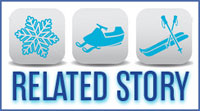
By Ruffin Prevost
CODY, WYO. — Gateway communities around Yellowstone National Park have been weighing in this week on the latest draft winter-use plan for managing snowmobiles and snow coaches in the park, with generally favorable reactions from snowmobile enthusiasts.
The plan calls for managing traffic by “transportation events” and grouping snowmobile riders in clusters of 7-10 sleds per event. It allows for a total of 110 daily transportation events, with a cap of 50 events for snowmobile riders. One event each day from each gate is reserved for unpaid guides.

Bert Miller, vice president of the Wyoming State Snowmobile association, said that the plan wasn’t perfect, “but there’s opportunity here.”
“I think a lot of us can try and work with the Park Service,” Miller said Thursday during a public meeting in Cody, Wyo., the last of four that included stops in Jackson, Wyo., Bozeman, Mont. and West Yellowstone, Mont.
“Hopefully we can move forward and get this alternative to start working. We’ve been doing this for a long, long time,” he said.
The last decade has seen constant legal wrangling over snowmobiles in the park, with several attempts at crafting a lasting winter-use plan stymied by court rulings that have required planners to start over. While previous plans have focused on a specific maximum number of snowmobiles allowed in the park each day, the new draft plan focuses instead on managing the total effects of noise, air pollution and human-wildlife interactions from snowmobiles and snow coaches, without regard to which mode of travel is used.
Terry Dolan — a snowmobile guide for Gary Fales Outfitting, the lone concessioner operating through Yellowstone’s East Gate — said he was optimistic that the plan could result in a lasting framework for managing winter travel in the park.
Dolan said he looked forward to unpaid guides and their guests traveling through the East Gate, and that he planned on renting best-available technology snowmobiles to them.
Park County Commissioner Loren Grosskopf, a longtime snowmobiler who has pushed for fewer restrictions in Yellowstone, said the plan was “a step in the right direction,” although he had concerns about how unguided visits would work under guidelines not yet fully completed.
Many attending the Cody meeting focused on details of the unpaid guide portion of the plan, which would use an online reservation system similar to one in place for permitting whitewater river rafting. Concerns centered on increasing the maximum number of unpaid sleds allowed from five to 7-10, as is the case for paid guide groups, as well as uncertainty about details and logistics of the proposed system which have not yet been worked out.
Yellowstone management assistant Wade Vagias said he welcomed additional detailed suggestions and questions about the unpaid guide program, which will be drafted with input from “all stakeholders” over the next several months.
No one expressed significant concerns about potential environmental problems during the public comment period of Thursday’s meeting in Cody, attended by more than 50 people. Yellowstone spokesman Al Nash said that questions at earlier meetings, particularly in Bozeman, focused on a wider range of topics and potential concerns.
Some environmental groups have complained that sound and emissions levels could potentially be higher under certain circumstances in the new plan, at least until 2017, when tougher vehicle technology standards take effect. The new plan also allows for more total snowmobiles each day, with a potential maximum of 480, compared to 318 under the current plan.
The existing plan will continue for a two-year transition period before the new plan takes effect.
The Park Service will receive public comments on the draft plan until Aug. 20, and will release a final plan in September.
Contact Ruffin Prevost at 307-213-9818 or [email protected].

I eagerly await the day I can return to Yellowstone to photograph during winter.